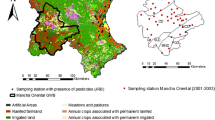Abstract
Between the years 1979 and 1984, investigations were conducted into 311 events of suspected contaminations of wells with pesticides. This involved the analyses of water from 359 wells where the suspected contamination originated from (i) spills (ii) spray drift or (iii) surface runoff waters carrying pesticides into wells. Investigations covered 83 spill events involving 104 rural wells; tests revealed 79 of these became contaminated. The contaminations were caused by (i) spills of pesticide concentrates (ii) back-siphoning of spray solutions and/or (iii) spills from overfilling, emptying or rinsing spray equipment. The pesticides either entered directly into the wells or contaminated the area in the vicinity of the wells. In spite of cleanup attempts, difficulty was experienced in decontaminating most well waters and some had to be abandoned. The longest period of monitoring a contaminated well was 1, 117 days; during that time the decline in residue was slow.
Investigations were made into 228 events involving 255 wells where spray drift and/or surface runoff waters with pesticides were observed as entering the well; however, only 55 were found to contain detectable residues. The highest proportion of these events was associated with surface runoff or spray drift from cornfields; of 86 wells involved only 26 contained measurable residues and all involved atrazine. Fifty-seven well investigations were associated with spraying right-of-ways and 16 waters were contaminated with 2,4-D and dichlorprop. The remaining 13 well contaminations were associated with various other land-use activities. It required 45 to 347 days to decontaminate these 55 wells.
Similar content being viewed by others
References
Beste LE (ed) (1983) Herbicide handbook, fifth edition. Weed Sci Society of Am, Champaign, Illinois
Braun HE, Frank R (1980) Organochlorine and organophosphorus insecticides: Their use in eleven agricultural watersheds and their loss to stream waters in Southern Ontario, Canada, 1975–1977. Sci Total Environ 15:169–192
Dalton RL, Pease HL (1962) Determination of residues of diuron, monuron, fenuron, and neburon. J Assoc Offic Agric Chem 45(2):377–381
Frank R, Braun HE, Holdrinet MVH (1981) Residues from past uses of organochlorine insecticides and PCB in waters draining eleven agricultural watersheds in Southern Ontario, Canada, 1975–1977. Sci Total Environ 20:255–276
Frank R, Braun HE, Sirons GJ, Holdrinet MVH, Ripley BD, Onn D, Coote R (1978) Stream flow quality—pesticides in eleven agricultural watersheds in Southern Ontario, Canada, 1974–1977. PLUARG Tech Rep, Int Joint Commission, Windsor, Ontario, Canada
Frank R, Braun HE, Holdrinet MVH, Sirons GJ, Ripley BD (1982) Agriculture and water quality in the Canadian Great Lakes Basin: V. Pesticide use in 11 agricultural watersheds and presence in stream water, 1975–1977, Environ Qual 11:497–505
Frank R, Fish N, Sirons GJ, Walker J, Orr HL, Leeson S (1983) Residues of polychlorinated phenols and anisoles in broilers raised on contaminated woodshaving litter. Poult Sci 62:1559–1565
Frank R, Sirons GJ (1980) Chlorophenoxy and chlorobenzoic acid herbicides: Their use in eleven agricultural watersheds and their loss to stream waters in Southern Ontario, Canada 1975–1977. Sci Total Environ 15:149–167
Frank R, Sirons GJ, Ripley BD (1979) Herbicide contamination and decontamination of well waters in Ontario, Canada 1969–78. Pestic Monit J 13:120–127
Holdrinet M (1974) Determination and confirmation of hexachlorobenzene in fatty samples in the presence of other residual halogenated hydrocarbon pesticides and polychlorinated biphenyls. J Assoc Offic Anal Chem 57:580–584
Mills PA, Bong BA, Kamps LR, Burke JA (1972) Elution solvent system for Florisil cleanup in organochlorine pesticide residue analysis. J Assoc Offic Anal Chem 55:39–43
Northover J, Ripley BD (1980) Persistence of chlorothalonil on grapes and its effect on disease control and fruit quality. J Agric Food Chem 28:971–974
Ramsteiner K, Hormann WD, Eberle EO (1974) Multiresidue method for the determination of triazine herbicides in fieldgrown agricultural crops, water and soil. J Assoc Offic Anal Chem 57:192–201
Ripley BD (1985) Gas chromatography-mass spectrometry of acylalanine fungicides. J Agric Food Chem 33:560–563
Ripley BD, Braun HE (1983) Retention time data for organochlorine, organophosphorus, and organonitrogen pesticides on SE-30 capillary column and application of capillary gas chromatography to pesticide residue analysis. J Assoc Offic Anal Chem 66:1084–1095
Sirons GJ, Frank R, Dell RM (1977) Picloram residues in sprayed MacDonald-Cartier Freeway right-of-way. Bull Environ Contam Toxicol 18(5):526–533
Sirons GJ, Frank R, Sawyer T (1973) Residues of atrazine, cyanazine and their phytotoxic metabolites in a clay loam soil. J Agric Food Chem 21:1016–1020
Sirons GJ, Paik YJ (May 1978) Extraction and quantitation of chlorinated phenols in aquatic substrates. Presented at International Symposium for the Analysis of Hydrocarbons and Halogenated Hydrocarbons in the Aquatic Environment. Hamilton, Ontario, Canada
Sirons GJ, Zilkey BF, Frank R, Paik NJ (1981) Residues of diphenamid and its phytotoxic metabolite in flue-cured tobacco. J Agric Food Chem 29:661–664
Sutherland GL (1964) 3-Amino-s-triazole. In Analytical Methods for Pesticides, Plant Growth Regulators, and Food Additives. G. Zweig, (ed) Vol IV, Chap 3, Academic Press. New-York
Yip G (1971) Improved method for determination of chiorophenoxy acid residues in total diet samples. J Assoc Offic Anal Chem 54:966–969
Yip G, Howard SF (1968) Extraction and cleanup procedure for the gas Chromatographie determination of four dinitrophenolic pesticides. J Assoc Offic Anal Chem 51(1):24–28
Worthing CR, Waiker SB (eds) (1983) The Pesticide Manual, 7th Ed, Brit Crop Prot Council, Croyden, UK
Author information
Authors and Affiliations
Rights and permissions
About this article
Cite this article
Frank, R., Clegg, B.S., Ripley, B.D. et al. Investigations of pesticide contaminations in rural wells, 1979–1984, Ontario, Canada. Arch. Environ. Contam. Toxicol. 16, 9–22 (1987). https://doi.org/10.1007/BF01055355
Received:
Revised:
Issue Date:
DOI: https://doi.org/10.1007/BF01055355




